Elbow Scabies: Symptoms, Treatment, and Prevention of Mite Infestations
What are the common symptoms of elbow scabies. How is scabies diagnosed and treated. Can scabies spread through casual contact. What complications can arise from untreated scabies infestations. How can scabies outbreaks be prevented in communal settings.
Understanding Scabies: A Microscopic Menace
Scabies is not an infection but an infestation caused by tiny mites known as Sarcoptes scabiei. These microscopic creatures burrow into the outer layers of human skin, causing an intense immune response. The result is a severely itchy rash that can be both uncomfortable and distressing for those affected.
Despite their minuscule size (less than half a millimeter long), these mites can cause significant discomfort. Most infested individuals only carry 10 to 15 mites at any given time, making them nearly invisible to the naked eye. Under a microscope, however, mites, eggs, and fecal matter can be identified from a skin scraping.
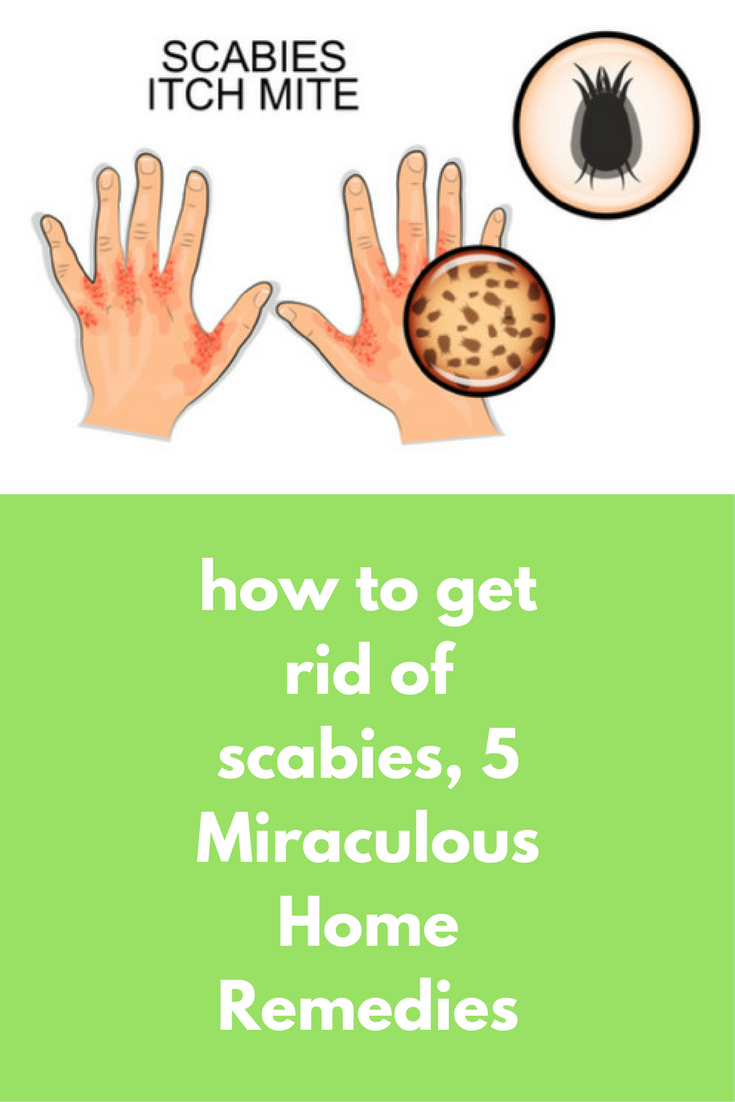
The Scabies Life Cycle
Female scabies mites create burrows just beneath the skin’s surface, laying 10 to 25 eggs inside each tunnel. These burrows appear as raised, grayish-white or skin-colored lines on the skin’s surface. As the mites reproduce and spread, the infestation worsens, leading to more severe symptoms.
Recognizing the Signs and Symptoms of Scabies
Identifying scabies early can be challenging, as symptoms may not appear for four to six weeks after the initial infestation. However, once the body reacts to the mites’ presence, several telltale signs emerge:
- Intense itching, particularly at night
- A pimple-like rash
- Scales or blisters on the skin
- Sores caused by persistent scratching
The relentless itch associated with scabies sets it apart from other skin conditions. This itching tends to be most severe in children and the elderly. While the rash can appear similar to acne or mosquito bites, the persistent and intense itching is a key differentiator.
Common Sites of Infestation
Scabies mites can infest any part of the body, but they have preferred locations:

- Between the fingers
- Wrist, elbow, and knee folds
- Around the waistline and navel
- On the breasts or genitals
- Head, neck, face, palms, and soles (in very young children)
Transmission and Risk Factors for Scabies
How does scabies spread from person to person? The primary mode of transmission is through prolonged skin-to-skin contact. This extended contact gives the slow-moving mites time to crawl from one individual to another. Contrary to popular belief, scabies is unlikely to spread through quick, casual contact like handshakes or hugs.
Shared personal items, such as bedding or towels, can occasionally facilitate transmission. However, it’s important to note that scabies mites cannot jump or fly, limiting their ability to spread rapidly.
High-Risk Groups
While anyone can contract scabies, certain groups are at higher risk:
- Sexually active adults
- Prison inmates
- Individuals in institutional care settings
- People living in crowded conditions
- Children and staff in daycare facilities
These high-risk environments often involve close, prolonged contact between individuals, creating ideal conditions for scabies transmission.

Scabies in Animals: Can Pets Transmit the Infestation?
Many pet owners wonder: Can I get scabies from my dog or cat? While animals can indeed suffer from scabies (commonly known as mange), the mites that cause these infestations are species-specific. Canine and feline scabies are caused by different mite species than those affecting humans.
It is possible to get mites from handling an infested pet, but these mites cannot reproduce in human skin. As a result, they typically die off without causing serious symptoms. This means that while pet owners should be cautious when handling animals with mange, the risk of developing a full-blown scabies infestation from pets is relatively low.
Crusted Scabies: A Severe Form of Infestation
Crusted scabies, also known as Norwegian scabies, is a particularly severe form of the infestation. In this variant, tens of thousands of mites can infest a single individual, leading to the development of thick, crusty skin lesions teeming with mites and eggs.

Who is most at risk for crusted scabies? This severe form is most common in:
- People with weakened immune systems
- The elderly
- Individuals with disabilities
Crusted scabies is highly contagious and requires immediate treatment to prevent outbreaks. The large number of mites present in crusted scabies makes it easier to spread through brief skin contact or contact with contaminated items.
Diagnosing Scabies: From Clinical Examination to Microscopic Confirmation
How do healthcare professionals diagnose scabies? In most cases, a doctor can identify scabies based on the appearance of the rash and the patient’s description of symptoms, particularly the intense itching. However, for a definitive diagnosis, a skin scraping may be performed.
The skin scraping process involves collecting a small sample of skin from the affected area. This sample is then examined under a microscope to look for mites, eggs, or fecal matter. While this method can provide conclusive evidence of a scabies infestation, it’s worth noting that a negative result doesn’t always rule out scabies, as the mites can be difficult to detect in small numbers.

Differential Diagnosis
Given that the scabies rash can resemble other skin conditions, healthcare providers must consider several potential diagnoses. Some conditions that may be mistaken for scabies include:
- Eczema
- Allergic reactions
- Insect bites
- Folliculitis
- Dermatitis herpetiformis
The presence of burrows and the intense, relentless itching are key factors that help distinguish scabies from these other conditions.
Treatment Options for Scabies: Eradicating the Infestation
Can scabies resolve on its own? Unfortunately, scabies will not go away without treatment. The only way to cure scabies is with prescription medications specifically designed to kill the mites. These treatments come in various forms, each with its own application method and duration.
Topical Treatments
The most common treatment for scabies involves applying a cream or lotion to the entire body from the neck down. These medications typically contain ingredients such as:
- Permethrin
- Lindane
- Crotamiton
- Ivermectin (topical formulation)
The medication is usually left on for 8 to 14 hours before being washed off. Depending on the specific treatment, this process may need to be repeated after a week.

Oral Medications
In some cases, particularly for severe or resistant infestations, doctors may prescribe oral medications. Ivermectin, taken as a pill, is the most common oral treatment for scabies. It’s often used for crusted scabies or when topical treatments have failed.
Regardless of the treatment method, it’s crucial to follow the prescribed regimen exactly as directed. Incomplete treatment can lead to reinfestation and the potential spread of scabies to others.
Preventing Scabies Outbreaks in Communal Settings
Scabies outbreaks can occur in various communal settings, from daycare centers to long-term care facilities. Preventing these outbreaks requires vigilance and proactive measures.
Daycare Centers
In daycare settings, children often engage in activities involving close skin-to-skin contact and may share nap mats or blankets. If scabies is detected in a child attending daycare, it’s crucial to:
- Notify the daycare staff immediately
- Treat the affected child and their family members
- Consider treating all classmates and caregivers, even if they’re not showing symptoms
- Wash all bedding, clothing, and toys used by the affected child in hot water
Long-Term Care Facilities
Nursing homes and facilities for the developmentally disabled are particularly vulnerable to scabies outbreaks due to the close contact between residents and caregivers. The Centers for Disease Control and Prevention (CDC) recommends:

- Screening all new patients and staff for scabies
- Implementing strict hand hygiene protocols
- Providing education on scabies recognition and prevention to staff and residents
- Promptly isolating and treating any suspected cases
By implementing these preventive measures, facilities can significantly reduce the risk of scabies outbreaks and protect their vulnerable populations.
Complications of Untreated Scabies: Beyond the Itch
While the intense itching of scabies is its most prominent symptom, leaving the infestation untreated can lead to several complications. The most common complication is secondary bacterial infection, often resulting from frequent scratching that breaks the skin.
Impetigo: A Common Complication
Impetigo, a bacterial skin infection, is frequently associated with untreated scabies. Symptoms of impetigo include:
- Honey-colored, oozing blisters
- Reddened, inflamed skin
- Crusty, yellowish scabs
When impetigo develops as a complication of scabies, treatment typically involves both addressing the underlying scabies infestation and prescribing antibiotics to combat the bacterial infection.

Other Potential Complications
In addition to impetigo, untreated scabies can lead to:
- Cellulitis: A deeper skin infection that can spread to the bloodstream
- Eczematization: Development of chronic, itchy skin patches
- Post-scabies syndrome: Persistent itching even after successful treatment
- Psychological distress: Due to persistent itching and social stigma
These potential complications underscore the importance of prompt diagnosis and treatment of scabies infestations.
Pictures of Rash & Mites, Symptoms, Treatment
Medically Reviewed by Stephanie S. Gardner, MD on November 22, 2022
Scabies is not an infection, but an infestation. Tiny mites called Sarcoptes scabiei set up shop in the outer layers of human skin. The skin does not take kindly to the invasion. As the mites burrow and lay eggs inside the skin, the infestation leads to relentless itching and an angry rash.
When a person is infested with scabies for the first time, it can take four to six weeks for the skin to react. The most common symptoms are:
- Intense itching, especially at night
- A pimple-like rash
- Scales or blisters
- Sores caused by scratching
In its early stages, scabies may be mistaken for other skin conditions because the rash looks similar. This image compares acne, mosquito bites, and scabies. What sets scabies apart is the relentless itch. Itching is usually most severe in children and the elderly.
Another hallmark of scabies is the appearance of track-like burrows in the skin. These raised lines are usually grayish-white or skin-colored. They are created when female mites tunnel just under the surface of the skin. After creating a burrow, each female lays 10 to 25 eggs inside.
These raised lines are usually grayish-white or skin-colored. They are created when female mites tunnel just under the surface of the skin. After creating a burrow, each female lays 10 to 25 eggs inside.
Scabies mites can live anywhere on the body, but some of their favorite spots include:
- Between the fingers
- The folds of the wrist, elbow, or knee
- Around the waistline and navel
- On the breasts or genitals
- The head, neck, face, palms, and soles in very young children
Most people with scabies only carry 10 to 15 mites at any given time, and each mite is less than half a millimeter long. This makes them very difficult to spot. To the naked eye, they may look like tiny black dots on the skin. A microscope can identify mites, eggs, or fecal matter from a skin scraping.
Scabies typically spreads through prolonged, skin-to-skin contact that gives the mites time to crawl from one person to another. Shared personal items, such as bedding or towels, may occasionally be to blame. Scabies can be passed easily between family members or sexual partners. It is not likely to spread through a quick handshake or hug. The scabies mite can’t jump or fly, and it crawls very slowly.
Scabies can be passed easily between family members or sexual partners. It is not likely to spread through a quick handshake or hug. The scabies mite can’t jump or fly, and it crawls very slowly.
Dogs and cats get scabies, too — better known as mange. However, canine scabies and feline scabies are not caused by the same type of mite that triggers human scabies. You can get mites from handling an infested pet, but these mites can’t reproduce in human skin. This means they usually die off without causing serious symptoms.
Anyone can get scabies, but those at higher risk include:
- Sexually active adults
- Prison inmates
- People in institutional care
- People living in crowded conditions
- People in child care facilities
Scabies outbreaks occasionally strike daycare centers. Young children tend to play in ways that involve skin-to-skin contact. They may also share naptime mats and blankets. If scabies is found in a child who attends daycare, it’s important to notify the staff. The child’s classmates and caregivers will probably need to be treated as well, even if symptoms have yet to appear.
The child’s classmates and caregivers will probably need to be treated as well, even if symptoms have yet to appear.
Long-term care facilities, including nursing homes and homes for the developmentally disabled, are also prone to scabies outbreaks. Because caregivers assist residents with bathing and dressing, skin-to-skin contact is common. The CDC recommends all new long-term care patients and staff be screened for scabies.
Also called Norwegian scabies, crusted scabies is a very severe infestation involving tens of thousands of mites on a single person. This causes the skin to develop thick crusts full of mites and eggs. Crusted scabies is most common in people with weakened immune systems, the elderly, and people who are disabled. This type of scabies is highly contagious and requires swift treatment to prevent outbreaks.
The intense itch of scabies makes it difficult to resist scratching. Frequent scratching can create open sores that are prone to infection. Bacterial skin infections, such as impetigo, are the most common complication of scabies. Symptoms may include honey-colored, oozing blisters. This type of infection is usually treated with antibiotics.
Symptoms may include honey-colored, oozing blisters. This type of infection is usually treated with antibiotics.
In most cases, a doctor can identify scabies based on the appearance of the rash and your description of the itch. Sometimes a skin scraping is used to confirm the diagnosis. This involves collecting skin from the affected area and using a microscope to check the sample for mites, eggs, or fecal matter.
Scabies will not go away on its own. It can only be cured with prescription medications that kill the mites. Treatment is a cream or lotion that is applied to the entire body from the neck down in most cases. It is left on for 8 to 14 hours and then washed off. In some cases, a doctor may prescribe pills to treat scabies. Treatment takes up to three days, depending on the medication used.
While prescriptions can kill scabies mites and their eggs, they don’t provide any immediate itch relief. To control itching, especially at night, antihistamine pills can help.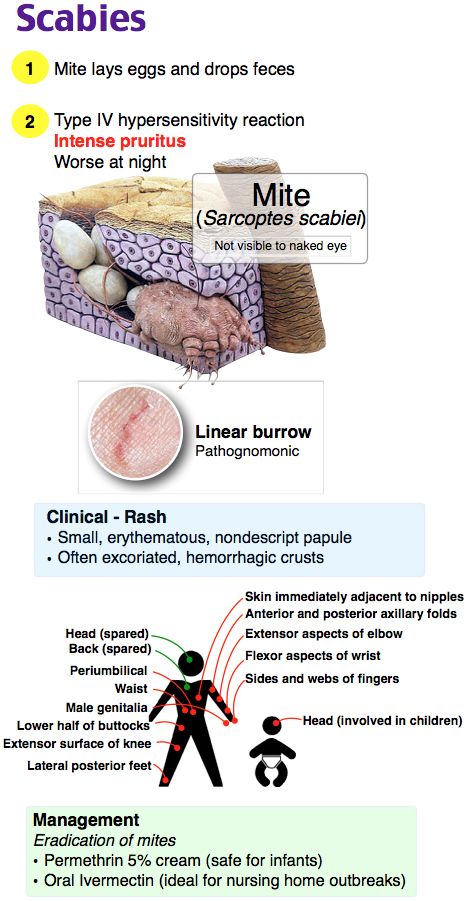 Hydrocortisone cream may also help, but it can change the appearance of the scabies rash, making the condition harder to diagnose. It’s best to use this cream only after your doctor has confirmed the diagnosis.
Hydrocortisone cream may also help, but it can change the appearance of the scabies rash, making the condition harder to diagnose. It’s best to use this cream only after your doctor has confirmed the diagnosis.
When someone is diagnosed with scabies, anyone who has close physical contact with the person should also be treated. Close contact includes bathing together, sleeping in the same bed, or even holding hands. Doctors usually recommend treating all members of the household, even if symptoms are not present. (Remember, it can take four to six weeks for symptoms to appear.)
Scabies mites can live up to two to three days on the surface of clothes, bedding, or towels. To make sure these mites are killed, wash any sheets and clothing used by the affected person within the past three days. Wash the items in hot water and dry them in a hot dryer or take them to a dry-cleaner. Items that can’t be washed should be placed in a sealed plastic bag for seven days.
Scabies medications can kill the mites and eggs quickly, and patients can usually return to school or work 24 hours after starting treatment. However, the itch may persist for a few weeks. This is the result of an ongoing allergic reaction in the skin. If the itching continues for more than four weeks or a new rash appears, see your doctor. It may be necessary to reapply scabies medication.
However, the itch may persist for a few weeks. This is the result of an ongoing allergic reaction in the skin. If the itching continues for more than four weeks or a new rash appears, see your doctor. It may be necessary to reapply scabies medication.
IMAGES PROVIDED BY:
1) Pixtal Images
2) Dr. P. Marazzi / Photo Researchers, Inc.
3) Rom Rom, ISM/Phototake, Interactive Medical Media LLC
4) John Radcliffe Hospital / Photo Researchers, Inc.
5) Dr. P. Marazzi / Photo Researchers, Inc.
6) Eye Of Science/Photo Researchers Inc.
7) LWA-Dann Tardif/Flirt Collection
8) Gregory Byerline
9) Erik Isakson/Tetra Images
10) Picture Partners/Age Fotostock
11) ERproductions/Blend Images
12) ISM/Phototake
13) Dr P. Marazzi / Photo Researchers, Inc.
14) HBSS/Fancy
15) Jupiterimages
16) Jochen Tack/Imagebroker.net
17) Lucianne Pashley/Age Fotostock
18) Steven Errico/Photographer’s Choice
19) Jim Craigmyle/Flirt
REFERENCES:
Centers for Disease Control and Prevention.
Delaware Department of Health and Human Services.
Peteducation.com.
The International Foundation for Dermatology.
The Nemours Foundation.
© 2022 WebMD, LLC. All rights reserved. View privacy policy and trust info
Cat Mange and Scabies: Symptoms, Causes, and Treatments
Written by WebMD Editorial Contributors
Reviewed by Vanesa Farmer, DVM on March 16, 2023
In this Article
- What Types of Mange Can Cats Have?
- How Can I Tell If My Cat Has Mange?
- What Is the Treatment for Mange in Cats?
Mange is a skin problem that affects many animals, including cats, but it’s not an illness. Mange is caused by tiny parasites called mites that bite your pet’s skin and cause itching, flaking, hair loss, and inflammation.
Scabies is a specific type of mange that is associated with the Sarcoptes species of mite, which causes sarcoptic mange.
Mange is uncommon in cats, so owners don’t always recognize it right away. It is highly contagious and can spread between pets, so it’s important to treat mites as soon as you can. There are several medicines that can effectively get rid of mange. Your veterinarian can help you find the best one for your cat.
It is highly contagious and can spread between pets, so it’s important to treat mites as soon as you can. There are several medicines that can effectively get rid of mange. Your veterinarian can help you find the best one for your cat.
There are several types of mange mites, which are tiny arachnids that burrow under the top layers of skin and cause discomfort to the host. Adult mites can lay eggs under the skin.
There are several types of mange in cats:
- Canine Scabies (Sarcoptic Mange): Despite the word “canine” in the name, these mites can affect cats as well. Cats usually get them from an affected dog living in the same house. They cause sores, hair loss, and itching.
- Feline Scabies (Notoedric Mange): Feline scabies are a different parasite than canine scabies, but the symptoms they cause are similar.
- Ear Mites (Otodectic Mange): Ear mites burrow inside your cat’s ears. They tend to be found inside the ear canal, but they can also affect the outer ear.
 They cause itching and can result in damage to your cat’s eardrum.
They cause itching and can result in damage to your cat’s eardrum. - Walking Dandruff (Cheyletiellosis): These mites get their name because they are small and white and move around a pet’s body. They affect many types of housepets and can also affect humans.
- Trombiculosis: These mites are more commonly known as chiggers. They attach themselves to your cat’s skin and feed on blood before dropping off. They look like small, orange ovals, and they may appear on your cat’s head, paws, or belly.
Feline demodicosis, which can cause itching and hair loss in cats that are already sick, is caused by demodex mites and is classified as mange.
Most cat owners suspect mange because their cat is scratching themselves more than usual. Mites are itchy and uncomfortable, so your cat will do whatever they can for relief. They will lick, bite, or scratch the affected spots.
Your cat’s attempts to stop the itching can worsen the problem by irritating their skin even more. The mites, along with the scratching, can result in hair loss and inflamed skin. You might see scaly patches of skin, sores, or scabs on your cat.
The mites, along with the scratching, can result in hair loss and inflamed skin. You might see scaly patches of skin, sores, or scabs on your cat.
With ear mites, cats shake their heads and lay their ears flat to relieve discomfort inside their ear canals. You may be able to see a buildup of heavy ear wax and mite residue in your cat’s ears.
You may also notice that you are being bitten by mites. Some mange mites can get onto humans and cause itching, redness, and swelling. However, these mites can’t breed on humans, so it’s much easier to get rid of them on yourself than on your pet. Talk to your doctor about treating mite bites on your skin.
If you suspect your cat has mange, you will need to take them to the vet for diagnosis and treatment. Your vet will take skin scrapings from the affected area and look at them under a microscope for evidence of mange mites.
There are several treatments for mange in cats, including some that are commonly used for preventing fleas and heartworm. However, the dosing for mites may be different, so make sure to speak with your vet.
However, the dosing for mites may be different, so make sure to speak with your vet.
Your vet may also suggest special shampoos or soothing medicines for any sores on your cat’s skin.
If you have other pets at home, your vet might tell you to treat them for mites or to isolate any affected pets so the mites won’t spread. You should also ask your vet for cleaning tips. Mites can linger on your pet’s bed, toys, or collar, as well as your carpets and furniture.
If your cat gets mange, make sure to follow your vet’s suggestions for treatment and follow-up care.
Top Picks
Treatment of scabies in Moscow – prices, an appointment at the Yuzhny clinic
The most common skin disease among those caused by parasites is scabies. The cause of itching and changes on the skin in the form of an erythematous papulovesicular rash is a scabies mite – itching.
The cause of itching and changes on the skin in the form of an erythematous papulovesicular rash is a scabies mite – itching.
According to medical statistics, more than 300 million cases of infection occur annually worldwide. She gets sick not only in countries with a low standard of living, but also in the most progressive states in terms of medical provision.
Treatment of scabies involves isolating the patient from contact with others and the use of special anti-scabies ointments and preparations. It is divided into specific, preventive and trial.
specific method. It is used when the disease is identified and confirmed.
preventive method. It is prescribed to persons who have come into contact with an infected person.
trial method. Used when scabies is suspected. As a rule, it is used when the disease proceeds in a latent form.
How to identify?
Itching with scabies in humans occurs, as a rule, in the evening or in the first half of the night. This is due to the fact that female ticks living on the skin of an infected person become active at this time, gnaw passages in tissues, feed, lay eggs and excrete excrement.
This is due to the fact that female ticks living on the skin of an infected person become active at this time, gnaw passages in tissues, feed, lay eggs and excrete excrement.
If you or your friends have itching that occurs at this particular time of day, and red and indurated dots appear on the skin – especially where the hair follicles are located – you should immediately limit contact with others and immediately seek medical help.
The incubation period for scabies lasts about two weeks. It is during this time that the larva grows to the size of an adult tick, capable of causing considerable discomfort to its victim. If the cause of infection was not a larva, but an already formed female, then the first signs of the disease appear very quickly – the very next day.
Symptoms and signs
In adults and children, in men and women, in the elderly, the course of the disease and the signs of scabies are somewhat different. However, the most important symptom that appears in almost all forms is itching.
The second symptom that allows you to accurately diagnose the disease is the presence of an itch in the patient.
What scabies looks like
There are two forms of scabies: typical and atypical . The typical form involves “moves” characteristic of the tick and occurs in the same places. On the surface of the skin there are whitish-gray passages ranging in size from one millimeter to 1 centimeter. The tick is visible through the skin as a black dot. The disease is localized in places between the fingers, on the wrists from their inner side, in the elbows, on the folds of the limbs, around the nipples and on the genitals.
An atypical form is a deviation from the normal course of the disease. Patients experience:
- The so-called “ hidden ” form. Absence of tick moves and other clinical signs.
- Scabious lymphoplasia – soft itchy dark red bumps in the armpits, abdomen, genitals.
- Scabious erythroderma – many small passages in atypical places and no pronounced itching.
 As a rule, it occurs in those who self-medicate, using unsuitable means for this.
As a rule, it occurs in those who self-medicate, using unsuitable means for this. - “Clean” scabies , also called “incognito” – mildly manifested in those who overly follow personal hygiene, taking water procedures several times a day. The symptoms of the disease become minimal.
- Norwegian – a severe form of the disease. It develops against the background of human immunodeficiency. Sometimes it is confused with psoriasis dermatitis due to a clear focus and whitish scales raised above the surface of the skin.
- Complicated . There are signs of secondary pyoderma and dermatitis, sometimes – microbial eczema or urticaria.
- Child . This form is characterized by a large spread of the process.
- Scabies in the elderly . Single passages are observed, their intact variants predominate. Few vesicles and papules.
Diagnostics
From the point of view of domestic dermatology, the following typical symptoms of scabies are distinguished for diagnosing the disease:
- Ardi’s symptom – pustules and crusts of pus are observed in the elbow area;
- “Gorchakova” – the presence of bloody crusts;
- “Michaelis” – in a patient in the intergluteal region and on the sacrum, crusts of clotted blood and an impetiginous rash appear;
- “Cesari” – the final sign in the diagnosis – the presence of scabies that rise above the skin.

The doctor collects an anamnesis, examines the victim, finds out if there was contact with other patients, determines the presence of a tick and its larvae. The course is detected by applying an iodine solution to the skin or applying mineral oil and pressing with glass. Sometimes a microscope may be required for examination: the doctor takes samples of the affected tissue and examines them for signs of infection.
Treatment of scabies in Yuzhny clinic
In our institution, scabies has been successfully and effectively treated for many years. Qualified specialists have the latest equipment for diagnosing diseases and modern methods of therapy that do not contradict the standards of treatment adopted in Russia.
At the first signs of the disease, we recommend making an appointment with the doctors of the dermatological department of the Yuzhny clinic.
Which doctor should I contact?
The disease is treated by a dermatologist. After talking and examining the patient, the specialist prescribes treatment with anti-scabpocidic drugs that destroy the passages of ticks and kill them.
After talking and examining the patient, the specialist prescribes treatment with anti-scabpocidic drugs that destroy the passages of ticks and kill them.
Scabies in adults
There are a large number of sebaceous glands in the areas of the neck, back and hair on the head. Therefore, in adults with scabies, as a rule, there are no passages in these places. For reproduction, mites need access to air, which is completely blocked by the produced sebum.
In children
It is much easier to get scabies in childhood than in adults. This is due to the fact that the skin of the child is much more tender, and the body is not yet strong. Therefore, scabies in children is common – they spend a lot of time in kindergartens, schools, and other institutions, where they become infected with various diseases from their peers. If quarantine measures are not taken in time, the disease can spread to the scale of a local epidemic.
Experts call a number of signs by which a parent may suspect scabies in a child:
- Sleep disorders;
- Capriciousness and weakness;
- The appearance of cracks on the surface of the skin;
- Itching in the evening and at night;
- Pinkish or whitish rash.

Preparations and ointments for scabies
For the treatment of scabies, the attending physician usually prescribes the following drugs, the action of which is aimed at the destruction of the mites themselves, their eggs and larvae:
- Benzyl benzoate as emulsion or ointment. It is prescribed for both adults and children from 3 to 7 years old, but in different concentrations (20% and 10%).
- Spregal is an aerosol that does not require constant application and is applied once for mild forms of the disease and repeatedly for severe cases. The medicine is harmless and applies to all categories.
- Sulfur ointment (33%) – used every day for a week. Dangerous for children under 3 years old, pregnant and lactating women.
- Perimetrin (5%) – ointment, used in the evening before bedtime for 3 days. The drug is contraindicated in children under one year old, women during breastfeeding.
- Crotamiton (10%) – also an ointment, is used every day until complete recovery.

To relieve itching, experts prescribe antihistamine tablets for scabies.
When treating and using external medicines, it is important to follow certain rules:
- Skin must be clean before treatment;
- No special equipment is required for application – all preparations are applied with washed hands with soap;
- Bed linen is changed before the first medication and after the course is completed;
- All persons who are close to the patient should also receive preventive treatment.
The specialist determines the choice of the drug, the duration of the course, the dosage based on the severity and type of the disease.
Prophylaxis
There are rules, following which, a person minimizes the risk of contracting a scabies mite after contact with a patient:
- Bath, shower or sauna twice a day;
- Use of laundry or tar soap;
- Timely cutting of nails;
- Having one sexual partner;
- Hygiene items must be personal;
- Regular handwashing;
- Avoid using toilet paper, paper towels and other disposable and reusable items in public places;
- Isolation of the patient in a separate ventilated room.

The infected person must be completely isolated from contact with people and suspended from visiting public places until complete recovery. At home, it is necessary to treat furniture and things that the infected person has come into contact with with antibacterial agents. For these purposes, anti-tick drugs are used.
Fabric items should be placed in airtight plastic bags for 3-5 days (the time during which female ticks die), and then washed.
All patients after recovery should be under dispensary observation – this allows you to avoid relapses, complications and prevent the spread of the disease.
As a preventive measure, medical institutions timely identify patients and establish the focus of an outbreak of the disease, organize and control measures for the disinfection of premises where infection has occurred.
Why we are trusted
We at Yuzhny Clinic have been successfully treating various types of diseases in Moscow since 1989 years old Behind us are tens of thousands of grateful patients who turned to the specialists of the clinic with their problems and received timely treatment.
An individual approach to each patient, a polite attitude, the use of modern and traditional methods, reasonable prices – this is what we meet with each patient.
We treat, not sell services. Therefore, people turn to us again and again, trusting the most precious thing that everyone has – health.
FAQ
Patients are concerned about many topics related to this disease. We have prepared answers to the most frequently asked questions. Before you ask a question, check if it has been answered below.
How long does it take for scabies?
It all depends on what drug the doctor prescribed, what stage the disease is in, the typical or atypical type of scabies in the patient.
On average, larvae die in 2-3 days during treatment, after 7-10 days the main symptoms of the disease disappear. Itching may continue for several days after therapy. If the itching has not stopped, new skin rashes have appeared – you have a relapse and you need to contact a dermatologist again.
What are the most effective ointments?
The most effective are considered to be permethrin, benzyl benzoate and sulfuric ointment. Medicines are effective only if they are used according to a given scheme, agreed with the attending physician.
Is it possible to be treated at home?
In no case. Remember that only a doctor can tell you how to treat scabies, diagnose it and prescribe certain drugs. Do not start the disease and seek medical help in time!
How is scabies contracted?
People who are in close contact with an itch patient are at risk. You can also get infected in public places – baths and saunas, toilets, hostels. The most susceptible to the disease are those who live with the victim under the same roof. The source of the disease is scabies itch – a mite that lays larvae in the skin. The more severe a disease is in a person, the more contagious it is.
Treatment of scabies | LDC №1 Lipetsk
Search. ..
..
| ||||||

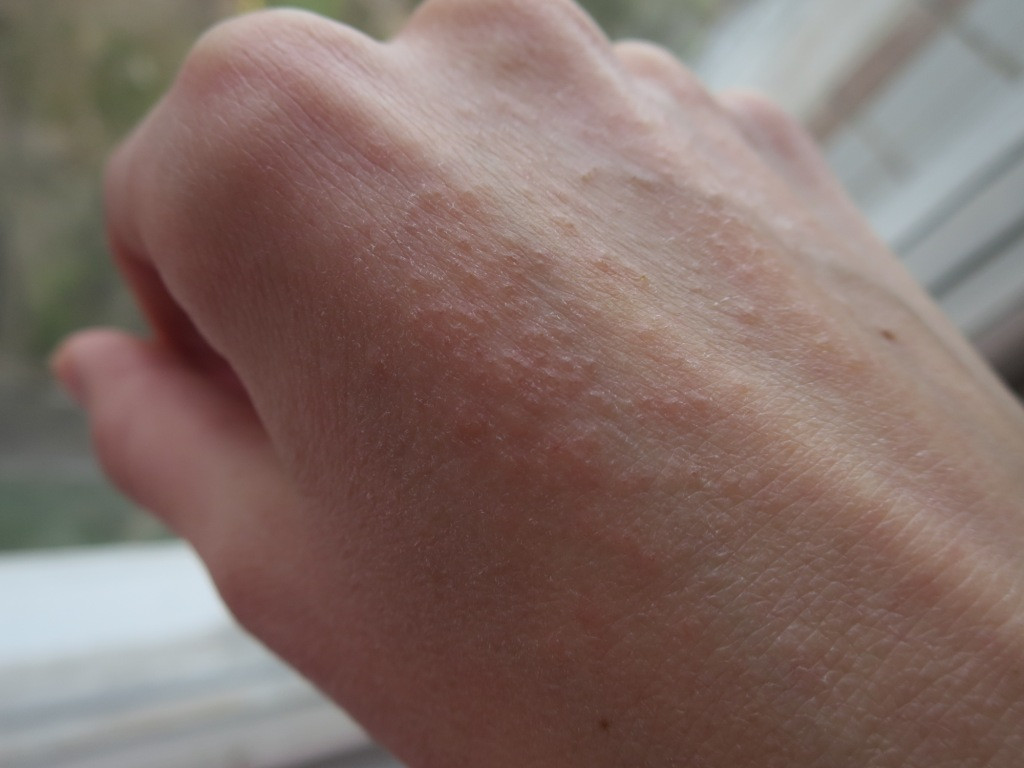 They cause itching and can result in damage to your cat’s eardrum.
They cause itching and can result in damage to your cat’s eardrum. As a rule, it occurs in those who self-medicate, using unsuitable means for this.
As a rule, it occurs in those who self-medicate, using unsuitable means for this.

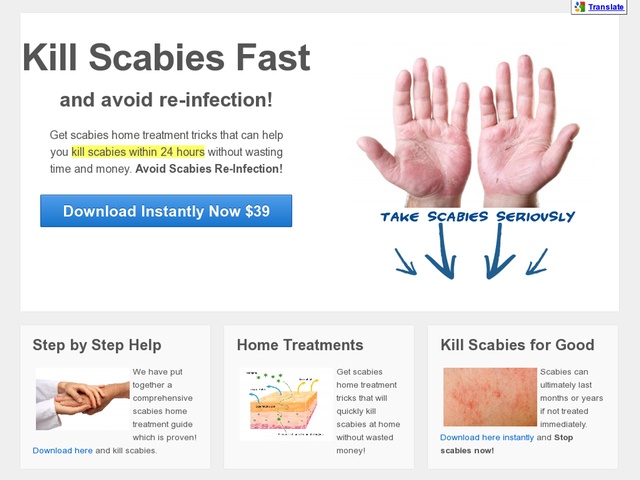
 They can even be seen with the naked eye. They look like a yellow or white dot the size of a poppy seed. The disease causes great discomfort, mainly due to excruciating itching.
They can even be seen with the naked eye. They look like a yellow or white dot the size of a poppy seed. The disease causes great discomfort, mainly due to excruciating itching.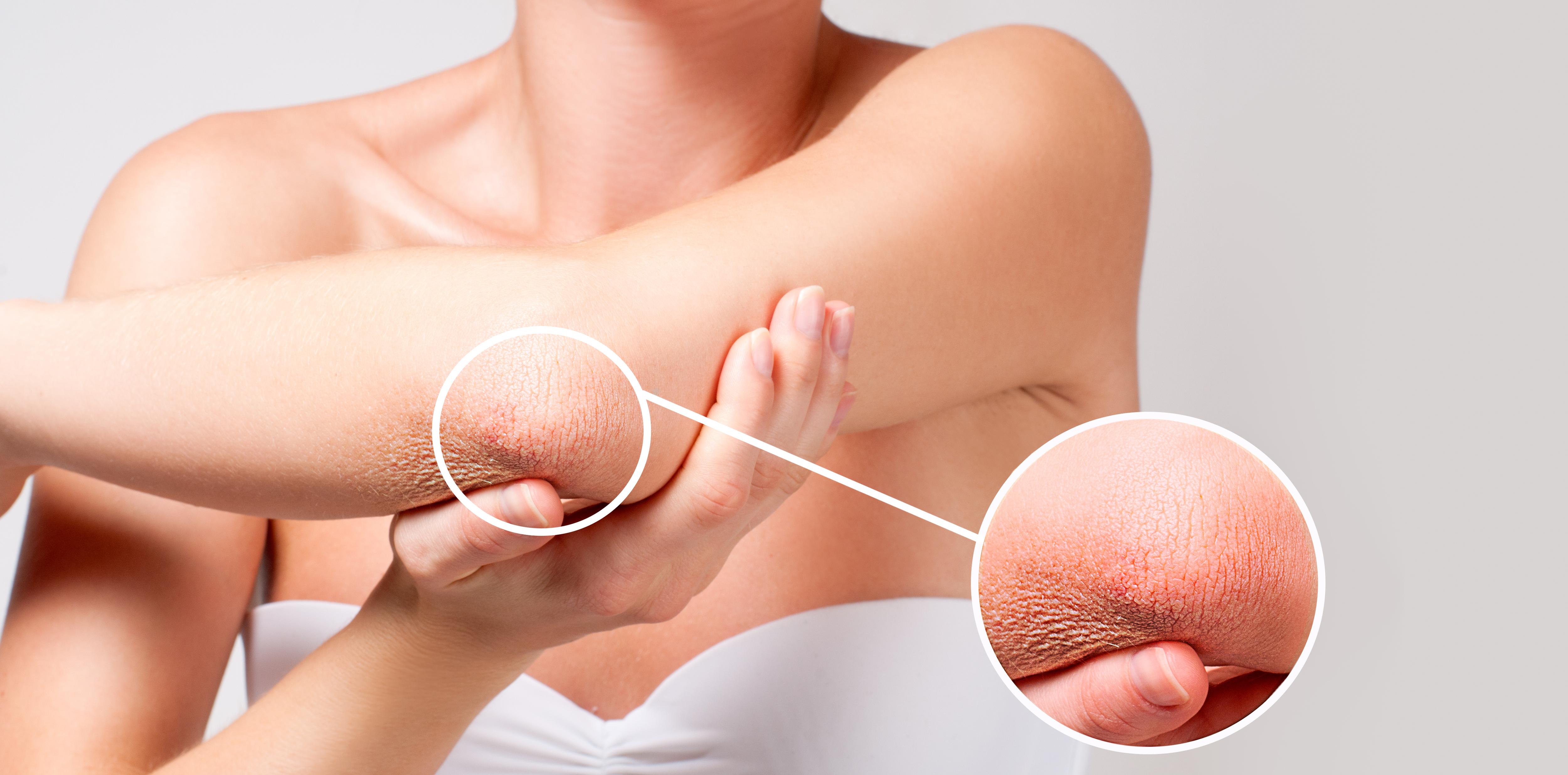 Penetrating under the skin, the parasite lays eggs there, which after a few days turn into larvae.
Penetrating under the skin, the parasite lays eggs there, which after a few days turn into larvae.